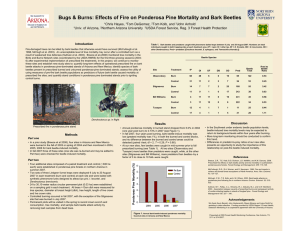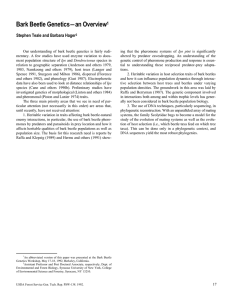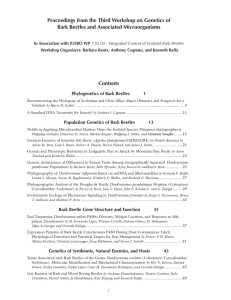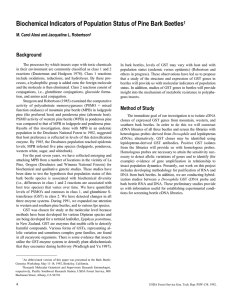Drought and Bark Beetles: Status Report and Plan for Research By
advertisement
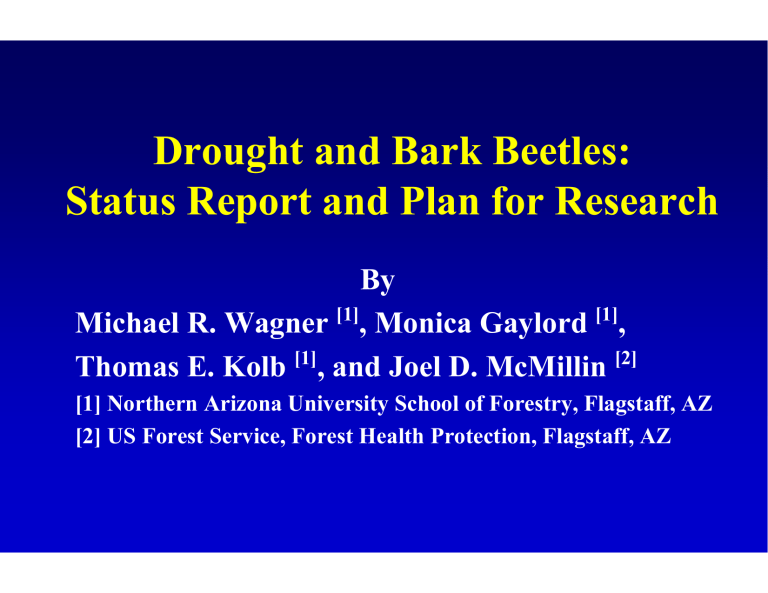
Drought and Bark Beetles: Status Report and Plan for Research By Michael R. Wagner [1], Monica Gaylord [1], [1] [2] Thomas E. Kolb , and Joel D. McMillin [1] Northern Arizona University School of Forestry, Flagstaff, AZ [2] US Forest Service, Forest Health Protection, Flagstaff, AZ Outline • • • • • • Current Drought Bark Beetles (BB) Drought/BB Impacts Drought or BB? Current Research Future Research Needs Above-average precipitation 3 2 1 Below-average precipitation 0 -1 -2 -3 BC AD 0 500 1000 1500 2000 Year (Grissno-Mayer et al. 1997; Wagner et al. 2000) Annual precipitation (inches) Annual Precipitation in Flagstaff, AZ (1976-2003) 40 35 30 25 20 15 10 5 0 50 yr (1951-2000) AVE ANN PRECIP = 21.7 inches 76 77 78 79 80 81 82 83 84 85 86 87 88 89 90 91 92 93 94 95 96 97 98 99 00 01 02 03 Year Pine Bark Beetles in Arizona Most important • Pine engraver beetles (Ips) -11 species in AZ • Western pine beetle • Roundheaded pine beetle • Mountain pine beetle • Southern and Mexican pine beetle (Chiricahua Mts.) • Larger Mexican pine beetle • Red turpentine beetle Least important No. of bark beetle species 35 30 25 20 15 10 5 0 Pine feeding Scolytidae in AZ Ponderosa limber pinyon Apache Host tree Chihuahua Bristlecone Mex ican pinyon No. of bark beetle species 5 Juniper feeding Scolytidae in AZ 4 3 2 1 0 Alligator Utah Rocky Mount. Hos tree Oneseeded Ponderosa Pine Bark Beetles Genus Ips Dendroctonus Pityophthorus Pityogenes Carphoborus Hylastes Hylurgops Pityoborus Pityokteines 9 No. of species, % 12 41.4% 6 20.7% 4 13.8% 2 6.9% 1 3.4% 1 3.4% 1 3.4% 1 3.4% 1 3.4% 29* 100.0% Available life history information Yes No Partial 3 6 3 6 0 0 0 4 0 0 1 1 0 1 0 0 0 1 1 0 0 0 1 0 0 1 0 10 14 5 (* potentially 5 additional species to be verified) Feeding Guild for Ponderosa Pine Bark Beetles Genus Species Small Trunks and Twigs branches Large branches Roots Ips 12 0 0 12 0 Dendroctonus 6 0 0 6 0 Pityophthorus 4 4 0 0 0 Pityogenes 2 0 0 2 0 Carphoborus 1 x x 0 0 Hylastes 1 0 0 1 x Hylurgops 1 0 0 1 x Pityoborus 1 x x 0 0 Pityokteines 1 0 0 1 0 29* 6 2 23 2 9 X: feeding on both tissue types; * Potentially 5 additional species to be verified Acres Ponderosa pine mortality caused by Dendroctonus and Ips spp. complex in AZ and NM, 1995-2003 500,000 450,000 400,000 350,000 300,000 250,000 200,000 150,000 100,000 50,000 0 AZ NM 1995 1996 1997 1998 1999 2000 2001 2002 2003 Year (Sources: Forest Insect and Disease Conditions in the SW Region, 1995-2003) Acres Ponderosa pine mortality caused by Ips beetles in AZ and NM, 1995-2003 500,000 450,000 400,000 350,000 300,000 250,000 200,000 150,000 100,000 50,000 0 AZ NM 1995 1996 1997 1998 1999 2000 2001 2002 2003 Year (Sources: Forest Insect and Disease Conditions in the SW Region, 1995-2003) Ponderosa pine mortality caused by Western pine beetles in AZ and NM, 1995-2003 60,000 AZ 50,000 NM Acres 40,000 30,000 20,000 10,000 0 1995 1996 1997 1998 1999 2000 2001 2002 2003 Year (Sources: Forest Insect and Disease Conditions in the SW Region, 1995-2003) Acres Ponderosa pine mortality caused by Mountain pine beetles in AZ and NM, 1995-2003 12,000 AZ 10,000 NM 8,000 6,000 4,000 2,000 0 1995 1996 1997 1998 1999 2000 2001 2002 2003 Year (Sources: Forest Insect and Disease Conditions in the SW Region, 1995-2003) Acres Ponderosa pine mortality caused by Roundheaded pine beetles in AZ and NM, 1995-2003 30,000 AZ 25,000 NM 20,000 15,000 10,000 5,000 0 1995 1996 1997 1998 1999 2000 2001 2002 2003 Year (Sources: Forest Insect and Disease Conditions in the SW Region, 1995-2003) The meaning of acres of bark beetle mortality • • • • • Area of bark beetle activity Intensity of mortality varies with activity polygon Qualitative decision made during aerial survey Same acre can have mortality over several years Number of dead trees estimated Pinon and ponderosa pine mortality detected from aerial survey in Arizona, 2001-2003 2001 2002 2003 40 Precipitation (inches) 35 Pinyon-Juniper, Oak woodland, And/Or Chaparral Spruce-fir 30 25 20 15 Ponderosa pine 10 Grass Land 5 4,000 5,000 6,000 7,000 8,000 Elevation (feet) 9,000 10,000 11,000 Drought or Bark Beetles? Correlation of bark beetles and drought Anecdotal reports of death w/o bark beetles Little evidence from skilled necropsy Rigorous experimental test is lacking Drought as inciting agent Conceptual understanding of inciting factors versus sustaining factors • Does it matter? • • • • • • Infested acres in AZ statewide Relationship between bark beetle infested acres and winter precipitation (January to April) 700,000 y = -3588.8x + 703791 R2 = 0.826, P = 0.033 2002 600,000 500,000 2003 400,000 300,000 200,000 2001 100,000 1994 2000 0 0 50 100 150 200 250 Winter precipitation (mm ) (Bark beetle species included the complex of Dendroctonus brevicomis, D. ponderosae, D. adjunctus, and Ips spp. on ponderosa pine) d Cri tic al T N2 hre sho l Z Epidemic Domain Beetle #’s N1 Endemic X Domain Y R2 Host Resistance R1 Does It Matter? • • • • • Drought can cause direct mortality Bark beetles can cause direct mortality Bark beetles require suitable host Outbreaks can persist after drought ends Active management (thinning) can reduce the risk of both drought and bark beetle mortality Southwest (AZ/NM) Ponderosa Pine Bark Beetle Research • • • • ≈ 40 Studies (manuscript) 80% in Progress 80% Flagstaff Based (NAU, RMRS, FHP) ≈ 95% Federal Funds Ponderosa Pine Bark Beetle Research Topics • • • • • Stand structure, density, restoration effects Tree physiology, resistance Life history, seasonal and elevational patterns Ecological effects (mistletoe, birds, CWD) Prevention and tree protection Important Research Questions • Can stand/landscape scale treatments mitigate bark beetle outbreak? • Are current fuel risk reduction treatments well suited for reducing bark beetle risk? • What will be the combined effect of thinning from below and bark beetles on future forest? Important Research Questions (Continued) • Which aspects of bark beetle community structure, life history strategy, and natural enemies are most important to population dynamics? • Long-term economic, social, and ecological effects of widespread loss of Arizona forests? • Are current monitoring tools (pheromone, aerial detection) adequate? Summary 9 Unprecedented tree mortality in SW 9 Probably drought induced 9 Likely related to overstocked forest condition 9 Outbreak will continue for several years 9 Paucity of basic understanding of all aspects of bark beetles 9 Coordinated SW research program needed << FHM Working Group Agenda


